Indie animator Don Hertzfeldt will work with a crew for the first time ever to produce his new feature "Antarctica."
Add a CommentViewing: Blog Posts Tagged with: hygiene, Most Recent at Top [Help]
Results 1 - 16 of 16
Blog: Cartoon Brew (Login to Add to MyJacketFlap)
JacketFlap tags: Don Hertzfeldt, Jeremy Platt, Keith Calder, Roxanne Benjamin, Snoot Entertainment, Susan Calder, Feature Film, Antarctica, Add a tag
Blog: OUPblog (Login to Add to MyJacketFlap)
JacketFlap tags: lakes, antarctic, *Featured, Online products, Earth & Life Sciences, Oxford Scholarship Online, microorganisms, #onlineproducts, antarctic lakes, jemma wadham, johanna laybourn-parry, lake ecosystems, mcmurdo dry valleys, The Antarctic, Geography, biology, antarctica, OSO, arctic, ecosystems, Add a tag
Antarctica is a polar desert almost entirely covered by a vast ice sheet up to four km in thickness. The great white continent is a very apt description. The ice-free areas, often referred to as oases, carry obvious life in lakes and occasional small patches of lichen and mosses where there is sufficient seasonal melt water to support them. The majority of ice-free areas lie on the coastal margins of the continent, but there is a large inland ice-free region called the McMurdo Dry Valleys.
On the face of it Antarctica would appear to offer little in the way of excitement for anyone interested in the physical, chemical, and biological characteristics of lakes. However, surprisingly Antarctica possesses the most diverse array of lakes types on the planet. The ice-free areas, which are bare rock, carry freshwater lakes and saline lakes, some as salty as the Dead Sea. Between land and ice shelves there are remarkable so-called epishelf freshwater lakes, that sit on seawater or are connected to the sea by a conduit and are consequently tidal. Underneath the vast ice sheet there are numerous subglacial lakes, around 380 at last count, of which Lakes Vostoc, Whillans, and Ellsworth are the best known. Ice shelves that occur around the edge of the continent overlying the sea, carry shallow lakes and ponds on their surface, and there are lakes on many of the glaciers. Some of these are short-lived and drain through holes called moulins to the glacier base, while others are several thousands of years old.
Antarctic lakes are extreme environments where only the most robust and adaptable organisms survive. Temperatures are always close to freezing and in saline lakes can fall below zero. While there is 24-hour daylight in summer, in winter the sun does not rise above the horizon, so the Sun’s light energy that drives the growth of the phytoplankton through photosynthesis is much lower on an annual basis than at our latitudes. The food webs of these lakes are truncated; there are few zooplankton and no fish. They are systems dominated by microorganisms: microscopic algae, protozoa, bacteria, and viruses. All of the lakes apart from the most saline have ice covers, that can be up to five metres thick. Lakes on the coastal margins usually lose part or all of their ice covers for a few weeks each summer, but the inland more southerly lakes of the McMurdo Dry Valleys have thick perennial ice covers that contain rocks and dust that have blown off the surrounding hills. This ‘dirty’ ice allows very little light to penetrate to the underlying water column, so the photosynthetic organisms that live there are adapted to extreme shade.

It would be reasonable to assume that during the austral winter biological processes in lake waters shut down. However, that is not the case; life goes on even in the darkness of winter. Bacteria manage to grow at low temperatures and many of the photosynthetic microorganisms become heterotrophic. They eat bacteria or take up dissolved organic carbon and are described as mixotrophic (meaning mixed nutrition). In this way they can hit the deck running when the short austral summer arrives and they can resume photosynthesis. Even the few crustacean zooplankton stay active in winter and don’t exploit resting eggs or diapause. They are crammed full with fat globules, which together with any food they can exploit takes them through the winter. Their fecundity is very low compared to their temperate relatives, but with no fish predators they can sustain a population.
Shallow lakes and ponds on ice shelves and glaciers freeze to their bases in winter. Thus their biotas have to be able to withstand freezing and in the case of saline ponds, increasing salinity as salts are excluded from the formation of ice.
The most topical and currently exciting lakes are the subglacial lakes kilometres under the ice sheet. These represent the modern age of polar exploration because gaining entry to these lakes presents major logistic challenges. One of the major issues is ensuring that the collected samples are entirely sterile and not contaminated with microorganisms from the surface. Subglacial lakes have been separated from the atmosphere for millions of years and potentially harbour unique microorganisms. In the past few years the US Antarctic programme has successfully penetrated Lake Whillans and demonstrated that it contains a diverse assemblage of Bacteria and Archaea in a chemosynthetically driven ecosystem (Christner et al. 2014). The British attempt to penetrate Lake Ellsworth was unsuccessful, but there are plans to continue the exploration of this lake in the future. In the coming years these extraordinary aquatic ecosystems will reveal more of their secrets.
The delicate surface lake ecosystems of Antarctica appear to respond rapidly to local climatic variations and where there are long-term data sets, as there are for the McMurdo Dry Valleys, to global climatic change. Unlike lakes at lower latitudes they are removed from the direct effects of Man’s activities that have changed catchment hydrology, and imposed industrial and agricultural pollution. Antarctic lakes are subject to the indirect anthropogenic effects of ozone depletion and climate warming. The impact of these factors can be seen without the superimposition of direct man-made effects. Consequently polar lakes, including those in the Arctic, can be regarded as sentinels of climate change.
Headline image credit: Lake Fryxell in the Transantarctic Mountains. Photo by Joe Mastroianni, Antarctic Photo Library, National Science Foundation. CCO via Wikimedia Commons
The post The lake ecosystems of the Antarctic appeared first on OUPblog.
Blog: Perpetually Adolescent (Login to Add to MyJacketFlap)
JacketFlap tags: Books, book review, growing up, Antarctica, Australian, Australian fiction, hobart, Book Reviews - Fiction, favel parrett, when the night comes, Add a tag
Past The Shallows was an exceptional novel and Favel Parrett has out done herself with her new book. When The Night Comes is a story of growing up, both as a child and as an adult. It is about journeys into the great unknowns. And that anything in life is possible. The story alternates between two points of view; […]
Add a CommentBlog: Perpetually Adolescent (Login to Add to MyJacketFlap)
JacketFlap tags: Book News, Antarctica, favel parrett, nella dan, when the night comes, Add a tag
Author Favel Parret on the inspiration behind her new novel When The Night Comes When I was about thirteen, the Antarctic supply vessel, MS Nella Dan ran aground on the windy and mysterious mountain in the Southern Ocean – Macquarie Island. Everyone was evacuated quickly and without injury, thanks to the organised crew and the […]
Add a CommentBlog: Topsy Turvy Land - Donna J. Shepherd (Login to Add to MyJacketFlap)
JacketFlap tags: Picture Book, book, Guardian Angel Publishing, Kevin Scott Collier, eBook, Dentist, hygiene, Gunk, donna j. shepherd, no more gunk, dental, Kevin Scott Collier, eBook, Guardian Angel Publishing, no more gunk, dental, Dentist, Gunk, hygiene, donna j. shepherd, ISBN 13: 978-1-933090-81-8, Add a tag
No More Gunk! is a Double Doozie - two books in one! This book is the first for a new imprint of Guardian Angel Publishing. The Health & Hygiene line features books teaching children about taking care of their bodies.In No More Gunk! by Donna J. Shepherd, short, playful rhymes and Kevin Scott Collier's humorous illustrations help children learn in a fun way the importance of proper dental
Blog: Monday Artday (Login to Add to MyJacketFlap)
JacketFlap tags: teeth, hygiene, Add a tag
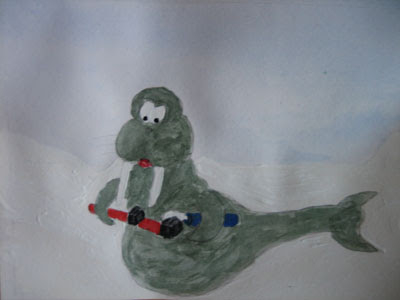 This is my first post for Monday Artday.
This is my first post for Monday Artday.
My title for it is:
'Brush your teeth twice a day'
Or maybe it should be:
'Brush your two teeth every day'
Blog: Monday Artday (Login to Add to MyJacketFlap)
JacketFlap tags: watercolour, hygiene, Samuli S, Add a tag
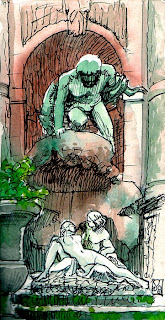 A bit of a stretch for the hygiene-theme but here it is anyway! These are statues in Paris in a fountain-pool. The pool had a kind of a green film covering it and a pidgeon sitting in a tree right above me decided to use my knee as her lavatory. I remember I did this probably the day after a drugged out man tried to rob my camera at knifepoint. I stuck to drawing for a while after that.
A bit of a stretch for the hygiene-theme but here it is anyway! These are statues in Paris in a fountain-pool. The pool had a kind of a green film covering it and a pidgeon sitting in a tree right above me decided to use my knee as her lavatory. I remember I did this probably the day after a drugged out man tried to rob my camera at knifepoint. I stuck to drawing for a while after that.
And Mike, there's a link at the bottom of this page that holds a translation for the comic :) Let me know if there are any problems with it.
This picture has also been on my blog and IF at some point.
Blog: Monday Artday (Login to Add to MyJacketFlap)
JacketFlap tags: weekly challenge, hygiene, zhm, Add a tag
Blog: Monday Artday (Login to Add to MyJacketFlap)
JacketFlap tags: hygiene, pascal kirchmair, Add a tag
So much for hygiene: 2 weeks ago, when I found worms in an old and forgotten piece of chocolate in the cupboard, it was time for me to clean the kitchen. As long as we have no rats...
Blog: Monday Artday (Login to Add to MyJacketFlap)
JacketFlap tags: pig, hygiene, Add a tag

Prudence learned from her mother that hygiene was very important, so she made sure to take a mud-bath every saturday.
Blog: Monday Artday (Login to Add to MyJacketFlap)
JacketFlap tags: hygiene, hello nurse, Add a tag
Blog: Monday Artday (Login to Add to MyJacketFlap)
JacketFlap tags: josh pincus, weekly challenge, hygiene, Add a tag
Mysophobia is a term used to describe a pathological fear of contact with dirt to avoid contamination and germs. Someone who has such a fear is often referred to as a "mysophobe". The term was introduced by William A. Hammond in 1879, when describing a case of obsessive compulsive disorder exhibited in repeated washing one's hands.
This phobia is sometimes referred to as germophobia (or germaphobia), a combination of germ and phobia to mean fear of germs, as well as bacillophobia and bacterophobia.
Mysophobia has long been related to OCD or washing one's hands, however Harry Stack Sullivan, an American psychologist and psychoanalyst, notes that while fear of dirt underlies the compulsion of a person with this kind of OCD, their mental state is not about germs, it is about the hands must be washed.
Blog: Monday Artday (Login to Add to MyJacketFlap)
JacketFlap tags: hygiene, Add a tag
Blog: Monday Artday (Login to Add to MyJacketFlap)
JacketFlap tags: elephant, hygiene, Add a tag
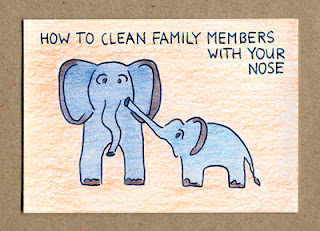
I'd like to say hi to everybody, because this is my first post here. So many inspiring things to see!
And here's my take on one of the two challenges this week: Elephant baby learns the hygiene basics of his species.
Blog: Monday Artday (Login to Add to MyJacketFlap)
JacketFlap tags: Patricia Cabana, hygiene, Godo, Add a tag

Godo loves taking a bath regularly :)
Blog: OUPblog (Login to Add to MyJacketFlap)
JacketFlap tags: Health, History, UK, smith, green, A-Featured, virginia, Leisure, hygiene, purity, clean, cosmetics, dirt, dirty, makeup, ecology, hot, springs, asceticism, virgins, Add a tag
I’m happy to confess here and now that I’m a girl who likes her mascara, and it’s a rare day that I appear in public without it. So, imagine my delight when our new book Clean came along. In it the author, Virginia Smith, explores the development of our obsession with personal hygiene, cosmetics, grooming, and purity. In the first of three posts, I’m happy to present the below short extract from the first chapter of the book.
Dirt is only matter out-of-place and is neither ‘good’ nor ‘bad’. Nature does not care what we think, or how we respond, to matter in all its forms. But as a species we do care, very deeply, about our own survival. A dense mass of human history clusters around the belief that dirt is ‘bad’, and that dirt-removal (cleansing) is always ‘good’. The old Anglo-Saxon word ‘clean’ was used in a wide variety of situations: it was often blatantly human-centred or self-serving in a way we might call ‘moral’; but it was also used more objectively as a technical term, to measure or judge material things relative to other things. It was thoroughly comprehensive, and unquestioned.
Preceding all human cultural history however – certainly before any human history of personal hygiene – were billions of years of wholly a-moral species development. The exact date one enters this endless time-line is almost irrelevant; what we are really looking for are the time-spans or periods when things speed up, which in the case of homo sapiens was somewhere between c.100,000-25,0000 BCE, followed by another burst of development after c.5000 BCE. Throughout this long period of animal species development, all of our persistent, over-riding, and highly demanding bio-physical needs were evolving and adapting, and providing the basic infrastructure for the later, very human-centred, psychology, technology and sociology of cleanliness.
It is difficult not to use ancient language when describing the egotistical processes of human physiology – routinely described as  the ‘fight’ for life – and in particular, our endless battle against poisonous dirt. Much of this battle is carried out below the level of consciousness. Most of the time our old animal bodies are in a constant state of defence and renewal, but we feel or know nothing about it; and the processes are virtually unstoppable. We can no more stop evacuating than we can stop eating or breathing – stale breath, of course, is also an expellation of waste matter. Ancient scientists were strongly focussed on the detailed technology of these supposedly poisonous bodily ‘evacuations’; and modern science also uses similarly careful technical terminology when describing bodily ‘variation’, ‘elimination’, ‘toxicity’ or ‘waste products’. In either language, old or new, inner (and outer) bodily ‘cleansing’ is ultimately connected to the more profound principle of ‘wholesomeness’ within the general system of homeostasis that balances and sustains all bodily functions.
the ‘fight’ for life – and in particular, our endless battle against poisonous dirt. Much of this battle is carried out below the level of consciousness. Most of the time our old animal bodies are in a constant state of defence and renewal, but we feel or know nothing about it; and the processes are virtually unstoppable. We can no more stop evacuating than we can stop eating or breathing – stale breath, of course, is also an expellation of waste matter. Ancient scientists were strongly focussed on the detailed technology of these supposedly poisonous bodily ‘evacuations’; and modern science also uses similarly careful technical terminology when describing bodily ‘variation’, ‘elimination’, ‘toxicity’ or ‘waste products’. In either language, old or new, inner (and outer) bodily ‘cleansing’ is ultimately connected to the more profound principle of ‘wholesomeness’ within the general system of homeostasis that balances and sustains all bodily functions.
Further extracts from other chapters of Clean can be found on Virginia Smith’s website.



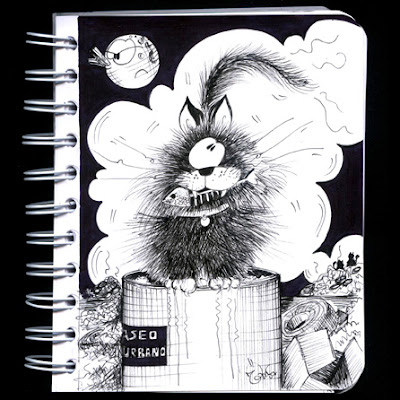

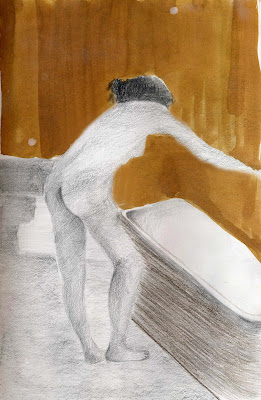
Welcome to Monday Artday! Cute drawing. Yep, even if you have only two teeth, you should brush them carefully.